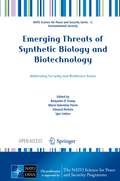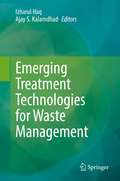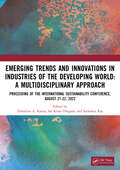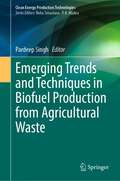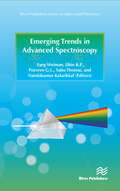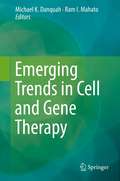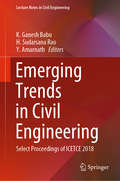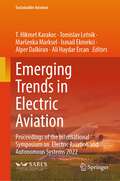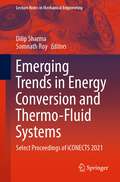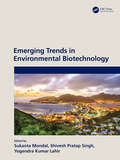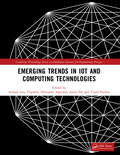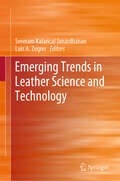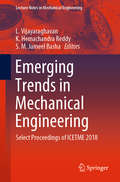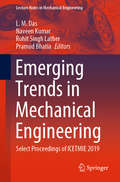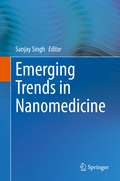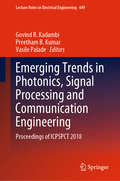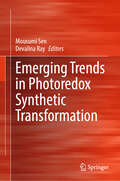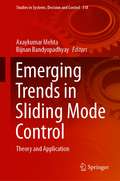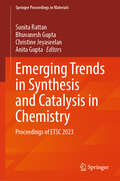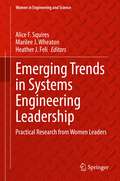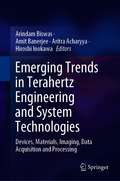- Table View
- List View
Emerging Threats of Synthetic Biology and Biotechnology: Addressing Security and Resilience Issues (NATO Science for Peace and Security Series C: Environmental Security)
by Igor Linkov Benjamin D. Trump Marie-Valentine Florin Edward PerkinsSynthetic biology is a field of biotechnology that is rapidly growing in various applications, such as in medicine, environmental sustainability, and energy production. However these technologies also have unforeseen risks and applications to humans and the environment. This open access book presents discussions on risks and mitigation strategies for these technologies including biosecurity, or the potential of synthetic biology technologies and processes to be deliberately misused for nefarious purposes. The book presents strategies to prevent, mitigate, and recover from ‘dual-use concern’ biosecurity challenges that may be raised by individuals, rogue states, or non-state actors. Several key topics are explored including opportunities to develop more coherent and scalable approaches to govern biosecurity from a laboratory perspective up to the international scale and strategies to prevent potential health and environmental hazards posed by deliberate misuse of synthetic biology without stifling innovation. The book brings together the expertise of top scholars in synthetic biology and biotechnology risk assessment, management, and communication to discuss potential biosecurity governing strategies and offer perspectives for collaboration in oversight and future regulatory guidance.
Emerging Treatment Technologies for Waste Management
by Ajay S. Kalamdhad Izharul HaqThis book is focused on the current status of industrial pollution, its source, characteristics, and management through various advanced treatment technologies. The book covers the recycle, reuse and recovery of waste for the production of value-added products. The book explores industrial wastewater pollution and its treatment through various advanced technologies and also the source and characteristics of solid waste and its management for environmental safety. It discusses new methods and technologies to combat the waste-related pollution and focuses on the use of recycled products. This book is of value to upcoming students, researchers, scientists, industry persons and professionals in the field of environmental science and engineering, microbiology, biotechnology, toxicology, further it is useful for global and local authorities and policy makers responsible for the management of liquid and solid wastes.
Emerging Trends and Innovations in Industries of the Developing World: A Multidisciplinary Approach
by Sai Kiran Oruganti Sudeshna Ray Dimitrios A. KarrasISC 2022 is dedicated to the Niti Aayog policies to promote sustainability through exchange of ideas emerging out of the academia. The ISC is an annual conference that is held in virtual mode until COVID restrictions on travel exist. The vision of the conference is to capacitate Academia with the necessary ideas that provide insights of the grassroot level development to various stakeholders of the Niti-Aayog policies. Towards this goal, the conference creates a conjunction of various stakeholders of Niti-Aayog policies that include- academic institutions, government bodies, policy makers and industry. The ISC organizers make concerted efforts to promote academic research that would technological, scientific, management & business practices, and insights into policy merits & disruptions. The framework of exchange of ideas is geared towards adoption of deep technologies, fundamental sciences & engineering, energy research, energy policies, advances in medicine & related case studies. This framework enables the round table discussions between the academia, industry and policy makers through its range of plenary and keynote speakers.
Emerging Trends and Techniques in Biofuel Production from Agricultural Waste (Clean Energy Production Technologies)
by Pardeep SinghThis edited book focuses primarily on biofuel production potential in agricultural waste, such as biogas generation, biohydrogen production, and research trends on managing or converting agricultural waste to biofuel. This book also draws attention to technological equipment, generated biofuels from agricultural waste through various biological and chemical processes, and the multiple factors responsible for biofuels from agricultural waste generation. Agriculture waste can be a renewable source of lignocellulosic feedstock for value-added products. Considering the non-replaceable fossil fuel reservoir, the exponentially growing human population urges an immediate search for alternative renewable energies. To confront the upcoming energy crisis, lignocellulosic agricultural waste is expected to be a sustainable, renewable, low-cost resource to derive bioenergy because of its high availability. This book will be of interest to researchers, scientists, and scholars working on agriculture waste management and biogas production. The book also serves as additional reading material for Industrial professionals, master's and degree students, policymakers, and NGOs working on biofuels and sustainable energy production.
Emerging Trends in Advanced Spectroscopy (River Publishers Series In Optics And Photonics Ser.)
by Sabu Thomas Nandakumar Kalarikkal Jibin K. P. Yang Weiman Praveen G. L.Experimental studies carried out by a spectroscopic approach, and the techniques used for investigating the acquired information, can be given a robust modern analytical framework in the design of new materials, and for emphasis on the expansion of physical foundations of new materials. Emerging Trends in Advanced Spectroscopy may help to understand the applications of spectroscopic tools in material characterization. The text also shows how different spectroscopic methods are used by researchers worldwide, and how we can correlate the experimental observations with structural information.Technical topics discussed in the book include: Geometries, electronic structures and vibrational spectral studies Advanced spectroscopic techniques in polymer chemistry Spectroscopic portrayals of graphitic structures fluorescent metal nanoclusters as sensory probes for metal ions colorimetric chemo sensor Nano mixed ferrites and their applications to nanoelectronics Solid phase astrochemistry
Emerging Trends in Cell and Gene Therapy
by Ram I. Mahato Michael K. DanquahExamples from various organs and diseases illustrate the potential benefit obtained when both therapeutic approaches are combined with delivery strategies. Representing the combined effort of several leading international research and clinical experts, this book, Emerging Trends in Cell and Gene Therapy, provides a complete account on and brings into sharp focus current trends and state-of-the-art in important areas at the interface of cell- and gene-based therapies. This book addresses the current fragmented understanding regarding these two research areas and fills the vast unmet educational need and interest of both students and researchers in academia and industry. Main features of the book: · Biological aspects of stem cell sources, differentiation and engineering. · Application of microfluidics to study stem cell dynamics · Potential clinical application of stem cells and gene therapy to specific human disease. · Utilization of biomaterials and stem cells in regenerative medicine with particular emphasis on spinal cord repair, ligament and bone tissue engineering. · Biomimetic multiscale topography for cell alignment.
Emerging Trends in Civil Engineering: Select Proceedings of ICETCE 2018 (Lecture Notes in Civil Engineering #61)
by K. Ganesh Babu H. Sudarsana Rao Y. AmarnathThis book comprises select papers from the International Conference on Emerging Trends in Civil Engineering (ICETCE 2018). Latest research findings in different branches of civil engineering such as structural engineering, construction materials, geotechnical engineering, water resources engineering, environmental engineering, and transportation infrastructure are covered in this book. The book also gives an overview of emerging topics like smart materials and structures, green building technologies, and intelligent transportation system. The contents of this book will be beneficial for students, academicians, industrialists and researchers working in the field of civil engineering.
Emerging Trends in Electric Aviation: Proceedings of the International Symposium on Electric Aviation and Autonomous Systems 2022 (Sustainable Aviation)
by T. Hikmet Karakoc Alper Dalkiran Ali Haydar Ercan Tomislav Letnik Maršenka Marksel Ismail EkmekciThe International Symposium on Electric Aviation and Autonomous Systems is a multi-disciplinary conference that presents research in the fields of aerospace, autonomous, and piloted unmanned systems. The 2022 conference provided a platform offering insights on a broad range of current issues in aviation, including hybrid, electric, all-electric, and fuel cell aerial vehicles, electric generation, energy storage, propulsion technology, and new identification and detection systems that adapt to the latest technology standards. ISEAS allows researchers, scientists, engineers, practitioners, policymakers, and students to exchange information, present new technologies and developments, and discuss future direction, strategies, and priorities in aviation and sustainability.
Emerging Trends in Energy Conversion and Thermo-Fluid Systems: Select Proceedings of iCONECTS 2021 (Lecture Notes in Mechanical Engineering)
by Somnath Roy Dilip SharmaThis book presents select proceedings of the International Conference on Energy Conversion and Thermo-fluid Systems (i-CONECTS 2021). It covers the latest trends in the areas of energy conversion and thermofluid systems. The topics covered include enhanced heat transfer, multi-phase flows, power generation technologies, fluid-structure interaction, alternative fuels, micro- and-nano-scale heat and mass transfer, energy, emissions control technologies, etc. The book will be a valuable reference for the researchers and professionals interested in the energy conversion technologies and allied fields.
Emerging Trends in Environmental Biotechnology
by Sukanta Mondal Shivesh Pratap Singh Yogendra Kumar LahirThe environment is an all-encompassing component of the ecosystem of "Blue planet - the earth", made up of the hydrosphere, atmosphere and lithosphere. These three spheres have biotic and abiotic components which exhibit ecological homeostasis that provides the most appropriate survival chances for the members of biotic component and geochemical balance with abiotic components. This ecosystem is subjected to relatively harsh conditions, mostly created by the disastrous activities due to natural calamities and intentional and/or accidental anthropogenic activities. Biotechnology has become a potential tool to dissipate such environmental impacts because of the advancement it has undergone recently. Emerging Trends in Environmental Biotechnology is an outstanding collection of current research that integrates basic and advanced concepts of biotechnology such as genomics, proteomics, bioinformatics, sequencing, and imaging processes to improvise and protect the environment. This book is particularly attractive for scientists, researchers, students, educators and professionals in environmental science, agriculture, veterinary and biotechnology science. The book will enable them to solve the problems about sustainable development with the help of current innovative biotechnologies such as recombinant DNA technology and genetic engineering which have tremendous potential for impacting global food security, environmental health, human and animal health and overall livelihood of mankind. Features Presents easy-to-read chapters Information is presented in a very accessible and logical format Identifies and explores biotechnological approaches for environmental protection Encompasses biodegradation of hazardous contaminants, biotechnology in waste management, nanotechnology, and issues in environmental biotechnology research
Emerging Trends in IoT and Computing Technologies: Proceedings of the International Conference on Emerging Trends in IoT and Computing Technologies-2023 (Conference Proceedings Series on Intelligent Systems for Engineering Designs)
by Suman Lata Tripathi Devendra Agarwal Anita Pal Yusuf PerwejSecond International Conference on Emerging Trends in IOT and Computing Technologies (ICEICT – 2023) is organised with a vision to address the various issues to promote the creation of intelligent solution for the future. It is expected that researchers will bring new prospects for collaboration across disciplines and gain ideas facilitating novel concepts. Second International Conference of Emerging Trends in IoT and Computer Technologies (ICEICT-2023) is an inventive event organised in Goel Institute of Technology and Management, Lucknow, India, with motive to make available an open International forum for the researches, academicians, technocrats, scientist, engineers, industrialist and students around the globe to exchange their innovations and share the research outcomes which may lead the young researchers, academicians and industrialist to contribute to the global society. The conference ICEICT- 2023 is being organised at Goel Institute of Technology and Management, Lucknow, Uttar Pradesh, during 12-13 January 2024. It will feature world-class keynote speakers, special sessions, along with the regular/oral paper presentations. The conference welcomes paper submissions from researcher, practitioners, academicians and students will cover numerous tracks in the field of Computer Science and Engineering and associated research areas.
Emerging Trends in Leather Science and Technology
by Sreeram Kalarical Janardhanan Luis A. ZugnoLeather and its products are globally traded commodities known for durability, fashion, reuse, repurpose, and resistance to degradation. Despite its benefits, the leather industry faces criticism from Non-Governmental Organizations (NGOs) due to its adverse environmental impact and often unfavourable labor conditions in non-certified tanneries. Efforts to enhance sustainability continue, yet challenges persist, prompting calls for revamping leather processing methods to ensure the industry's future compliance requirements. This monograph, through its 17 chapters, aims to address the multifaceted challenges and opportunities within the leather manufacturing industry, encompassing leather processing, product creation, and policy frameworks. The monograph includes contributions made by researchers, scientists, government officials, industry stakeholders, policymakers, and practitioners from more than 10 countries. It underscores the necessity for developing nations to grasp, address, and enhance their processing and manufacturing infrastructure including labor practices as well as meet export standards, to attain sustainability and compliance. Moreover, the book delves into formulating robust policies governing the leather processing and product sector, emphasizing the need for stringent regulations to mitigate adverse environmental impacts. By offering insights into smart and sustainable leather and leather product manufacturing practices, the book serves as a valuable resource for leather professionals and other stakeholders
Emerging Trends in Mechanical Engineering: Select Proceedings of ICETME 2018 (Lecture Notes in Mechanical Engineering)
by L. Vijayaraghavan K. Hemachandra Reddy S. M. Jameel BashaThis book comprises select proceedings of the International Conference on Emerging Trends in Mechanical Engineering (ICETME 2018). The book covers various topics of mechanical engineering like computational fluid dynamics, heat transfer, machine dynamics, tribology, and composite materials. In addition, relevant studies in the allied fields of manufacturing, industrial and production engineering are also covered. The applications of latest tools and techniques in the context of mechanical engineering problems are discussed in this book. The contents of this book will be useful for students, researchers as well as industry professionals.
Emerging Trends in Mechanical Engineering: Select Proceedings of ICETMIE 2019 (Lecture Notes in Mechanical Engineering)
by Naveen Kumar L. M. Das Rohit Singh Lather Pramod BhatiaThis book consists of select proceedings of the International Conference on Emerging Trends in Mechanical and Industrial Engineering (ICETMIE) 2019. It covers current trends in thermal, design, industrial, production and other sub-disciplines of mechanical engineering. This volume focuses on different areas of design engineering including computational mechanics, computational fluid dynamics, finite elements in modelling, simulation, analysis and design, kinematics and dynamics of rigid bodies, micro- and nano-mechanics, solid mechanics and structural mechanics, vibration and acoustics, applied mechanics, and biomechanics. It also covers various topics from thermal engineering including refrigeration plants, heat exchangers, heat pumps and heat pipes, combined heat and power and advanced alternative cycles, polygeneration, combustion processes, heat transfer, solar cells, solar thermal power plants, and the integration of renewable energy with conventional processes. This book will be useful for students, researchers as well as professionals working in the area of mechanical engineering, especially thermal engineering and engineering design and other allied areas.
Emerging Trends in Microbial Electrochemical Technologies for Sustainable Mitigation of Water Resources Contamination: Microbial Electrochemical Technologies in Wastewater Treatment
by Joyabrata Mal Rangabhashiyam Selvasembian Dakeshwar Kumar Verma Sovik Das Ioannis AnastopoulosThe book aims to highlight the application of microbial electrochemical technologies, their fundamental to advanced, recent applications, management strategies, and relevant case studies. The book also attempts to highlight existing research and technological advancements on all facets of instruments and methods for assessing and keeping track of water contaminants. The section on current trends and advancements in this book discusses the most recent advancements in microbial electrochemical technologies and related technologies to lessen the contamination of water resources. The book goes into great detail about the fundamental aspects of water pollution, including their causes, primary sources, detection, treatment, and mitigation using microbial electrochemical technologies and management systems as well as commercialization and economics thoughts that are currently of significant importance. Additionally, with the aid of appropriate tables and figures, all of these chapters havebeen arranged according to recent developments and aspects of the field. The book's goal is to give readers a fundamental understanding of how microbial electrochemical technologies work. It is intended for a wide range of readers, including undergraduate and graduate students, researchers, academicians, environmentalists, policymakers, businesspeople, and R&D teams. We gratefully thank all of the authors. We'll be open to recommendations for making the next book or edition better.
Emerging Trends in Nanomedicine
by Sanjay SinghThis book illustrates the significance of nanotechnology in the delivery of anticancer and antimicrobial drugs, biomimetic technologies, tissue engineering, sensing, diagnostics, and artificial enzymes. It first briefly discusses the use of nanotechnology for the delivery of anticancer medications, and the concept and applications of catalytically active nanomaterial-based artificial enzymes for sensing and diagnostic applications. It then explores the use of silver nanoparticle-based novel antimicrobials, and comprehensively reviews the role of nanomaterials in developing biomedical implants and tissue engineering applications. Lastly, it offers a detailed description of nanotherapeutics for combating human protozoan parasitic infections. Cutting across the disciplines, this book serves as a guide for researchers and scientists in biotechnology, medical science and material science.
Emerging Trends in Nanotechnology
by Zishan Husain KhanThis book discusses new trends in nanotechnology. It covers a wide range of topics starting from applications of nanomaterials in perovskite solar cells, pharmacy, and dentistry to self-assembled growth of GaN nanostructures on flexible metal foils by laser molecular beam epitaxy. It also includes other interesting topics such as advancement in carbon nanotubes; processing techniques, purification and industrial applications, metal di-chalcogenides for waste water treatment and recent advancement in nanostructured-based electrochemical genosensors for pathogen detection and many more. The book will be of great interest to researchers, professionals and students working in the areas of nanomaterials and nanotechnology.
Emerging Trends in Photonics, Signal Processing and Communication Engineering: Proceedings of ICPSPCT 2018 (Lecture Notes in Electrical Engineering #649)
by Vasile Palade Govind R. Kadambi Preetham B. KumarThis volumes presents select papers presented during the International Conference on Photonics, Communication and Signal Processing Technologies held in Bangalore from July 18th to 20th, 2018. The research papers highlight analytical formulation, solution, simulation, algorithm development, experimental research, and experimental investigations in the broad domains of photonics, signal processing and communication technologies. This volume will be of interest to researchers working in the field.
Emerging Trends in Photoredox Synthetic Transformation
by Mousumi Sen Devalina RayThis book covers the basic concepts and applications of photoredox processes. This book highlights the applications of photoredox reactions in waste management, photoremediation, photodeposition, photocatalysis, sustainable therapeutic approaches, natural product synthesis and derivatization to photocatalytic degradation and beyond. The challenges associated with the application of synthetic transformations are the hazardous economic reaction conditions. It further discusses the application of these mechanisms in drug derivatization and degradation. The book also covers the topic of nano-photocatalyst for drug-free therapeutics. This book is useful for researchers and professionals in the various areas of applied chemistry and biotechnology and allied fields.
Emerging Trends in Plant Pathology
by Birinchi Kumar Sarma Krishna P. Singh Shamarao JahagirdarThis book offers a comprehensive guide to the identification, detection, characterization, classification and management of plant pathogens and other beneficial microbes in agriculture. The science of plant pathology is a dynamic field and, given the growing interest in sustainable agricultural practices, plant disease management has also gained importance. Further, there has been a shift from traditional chemical-based methods to eco-friendly integrated disease management strategies with a greater focus on bio-control and other eco-friendly technologies. This book provides a comprehensive and timely account of latest concepts and advances in the field of plant pathology, including detection and diagnosis, host resistance, disease forecasting and plant biotechnological approaches. Accordingly, it will be of great interest to academics and all stakeholders working in the fields of plant pathology, microbiology, biotechnology, plant breeding, and other life sciences.
Emerging Trends in Sliding Mode Control: Theory and Application (Studies in Systems, Decision and Control #318)
by Axaykumar Mehta Bijnan BandyopadhyayThis book compiles recent developments on sliding mode control theory and its applications. Each chapter presented in the book proposes new dimension in the sliding mode control theory such as higher order sliding mode control, event triggered sliding mode control, networked control, higher order discrete-time sliding mode control and sliding mode control for multi-agent systems. Special emphasis has been given to practical solutions to design involving new types of sliding mode control. This book is a reference guide for graduate students and researchers working in the domain for designing sliding mode controllers. The book is also useful to professional engineers working in the field to design robust controllers for various applications.
Emerging Trends in Sustainable Geotechnics: Keynote Volume of EGRWSE 2024 (Lecture Notes in Civil Engineering #584)
by Krishna R. Reddy Arvind Kumar Agnihotri Eugeniusz Koda Magdalena Daria VaverkováThis volume contains peer-reviewed and selected papers presented during the International Conference on Environmental Geotechnology, Recycled Waste Materials, and Sustainable Engineering 2024, held in Warsaw, Poland. It covers the recent innovations, trends, concerns, practical challenges encountered, and the solutions adopted in waste management and engineering, geotechnical and geoenvironmental engineering, infrastructure engineering, and sustainable engineering. This book will be useful for academics, educators, policymakers, and professionals working in the field of civil engineering, chemical engineering, environmental sciences, and public policy.
Emerging Trends in Synthesis and Catalysis in Chemistry: Proceedings of ETSC 2023 (Springer Proceedings in Materials #51)
by Anita Gupta Sunita Rattan Bhuvanesh Gupta Christine JeyaseelanThis book presents the select papers from the International Symposium on “Emerging Trends in Synthesis and Catalysis” (ETSC 2023). It covers the latest trends in novel synthesis strategies and highly efficient heterogeneous/homogeneous catalytic chemical species. Various topics covered in this book are green synthesis, reaction designs, catalyst synthesis, advanced materials for organic synthesis, polymer synthesis, stereoselective synthesis, flow chemistry, bio-catalysis, organo-catalysis, catalysis for sustainable development and industrial processes, multiphase catalysis, separation science and process development, organometallic compounds in synthesis and catalysis, computational tools for synthetic processes and processes for environment sustainability. The book is useful for researchers, academicians, and industrialists working in material science and industrial chemistry.
Emerging Trends in Systems Engineering Leadership: Practical Research from Women Leaders (Women in Engineering and Science)
by Marilee J. Wheaton Alice F. Squires Heather J. FeliThis book celebrates the efforts of women in the international systems engineering community. While there are dozens of books that tackle the topic of systems engineering and thousands of books that address leadership, this book is unique. Emerging Trends in Systems Engineering Leadership: Practical Research from Women Leaders presents personal, well-researched, hands-on perspectives of emerging trends in systems engineering leadership from industry, government, and academia, covering timely topics applicable across many domains – all under one cover. This book presents material for engineers, scientists, technologists, and others to help them tackle challenges in their everyday work dealing with complex socio-technical systems. The book provides guidance for leaders on shoring up essential (soft) skills to address the increasing demand for professional competencies; addresses diversity, equity, inclusion, and empowering women in the workforce; discusses broader facets of systems engineering leadership including systems thinking, ethics and utilitarianism; and investigates the impact of emerging technological change on systems resilience and the digital enterprise. This book provides a multi-perspective approach for leaders to navigate a changing world and develop and deliver optimal system solutions to global societal challenges that meet human needs. To this end, the authors extend beyond the solid technical base to encompass the human aspect of system behavior. This book is written by twenty-six female authors (three of whom also serve as the editors) from around the world at varying career stages who share their research, achievements, perspectives, and successes in emerging areas of systems engineering leadership.Testimonials:“As the systems that modern society depends on get more complicated and complex, we are in the midst of a renaissance with regard to research relating to systems engineering and science. A vast majority of this research is focused on the development of a modern toolkit for systems engineers today and into the future. This takes the form of new and improved methods, models, methodology, processes and tools. This research is critical but likely insufficient without a focus on the most valuable resource with regard to systems engineering within any organization – the human resource. Therein lies the focus of this textbook. It addresses systems engineering leadership from a variety of perspectives, while also addressing broad aspects relating to mentoring and the necessary evolving competencies that we need to address in today’s workforce. This emphasis makes this book unique. The icing on the cake is that all the chapters in this textbook are written by contemporary women leaders – this provides a necessary and unique perspective on the topic of leadership – that is long overdue! I highly recommend this textbook to all my colleagues in academia, industry, and government.”Dinesh Verma, Ph.D.Professor, Systems Engineering, School of Systems and EnterprisesExecutive Director, Systems Engineering Research Center (SERC)Stevens Institute of Technology, Hoboken, NJ 07030“The past decade has seen a dramatic increase in the number of women who are formally recognized in systems engineering technical, management and leadership positions in all sectors. With industry, academia, professional systems engineering societies and publishers enabling and illuminating the growing and substantial contributions of women in engineering, women have unprecedented opportunities today to contribute to systems engineering in both leadership and management positions. This volume, a compendium of chapters written by enterprising international women leaders at various stages in their career, addresses diverse topics such as leadership, management, empowerment, equity, diversity, inclusion, and mentoring. It is a valuable resource f
Emerging Trends in Terahertz Engineering and System Technologies: Devices, Materials, Imaging, Data Acquisition and Processing
by Amit Banerjee Arindam Biswas Aritra Acharyya Hiroshi InokawaThis book highlights emerging trends in terahertz engineering and system technologies, mainly, devices, advanced materials, and various applications in THz technology. It includes advanced topics such as terahertz biomedical imaging, pattern recognition and tomographic reconstruction for THz biomedical imaging by use of machine learning and artificial intelligence, THz imaging radars for autonomous vehicle applications, THZ imaging system for security and surveillance. It also discusses theoretical, experimental, established and validated empirical work on these topics and the intended audience is both academic and professional.
